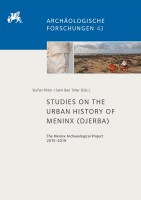Search
Editors: Ritter, Stefan; Ben Tahar, Sami
Studies on the Urban History of Meninx (Djerba)
The Meninx Archaeological Project 2015–2019
2022
21.0 x 29.7 cm, 454 p., 189 illustrations color, 474 illustrations b/w, 11 Beilagen, hardback
ISBN: 9783752006117
21.0 x 29.7 cm, 454 p., 189 illustrations color, 474 illustrations b/w, 11 Beilagen, hardback
220,00 €
ISBN: 9783752006117
Short Description
This volume offers a synthesis of the multifaceted results of a Tunisian-German research project carried out at the ancient seaport of Meninx on Djerba. Geophysical prospection clarified the internal structure of the sprawling city, which was famous as a center of purple dye production. Targeted excavations provided exemplary insight into various spheres of urban life in all periods of the settlement history, from the 4th century B.C. to the 7th century A.D. In addition, underwater archaeological investigations have shed light on the previously unknown harbour facilities of Meninx.Description
Meninx was the eponymous capital of the island of Djerba in Antiquity. The spacious seaport, situated on a protected gulf, was famous as one of the main production centres of purple dye in the Mediterranean and developed into one of the largest metropolises in Roman North Africa. In 2015, an archaeological research project was initiated in cooperation between the Institute of Classical Archaeology at the University of Munich and the Institut National du Patrimoine, Tunisia, in order to explore the urban development of this previously little-known ancient site. First, the internal urban structure was clarified by means of a large-scale geophysical prospection. Then, during two field research campaigns in 2017 and 2018, targeted excavations were carried out, which, together with their rich and diverse finds, provided exemplary insight into various spheres of urban life in all periods of the city's history, from Punic times to Late Antiquity (4th century B.C. to 7th century A.D.). In addition, underwater archaeological investigations have for the first time shed light on the harbour facilities of Meninx.The present volume offers a synthesis of the multifaceted results of these investigations. lt has become clear that Meninx, with its regional and supra-regional economic contacts, played a central role for the island, which functioned as a hub between Mediterranean maritime trade networks and the nearby mainland with its trading routes leading into the Sahara. In its role as a centre of production and trade, Meninx was strikingly different from the other Tripolitan coastal metropolises, Sabratha and Lepcis Magna, in that urban life was entirely focused on the sea and its resources.




 Preface
Preface

 Neuerscheinungen 2023/2024
Neuerscheinungen 2023/2024
 Gesamtverzeichnis 2023/2024
Gesamtverzeichnis 2023/2024
 Katalog Oriental Studies & Linguistics
Katalog Oriental Studies & Linguistics
 Mittelalter
Mittelalter
 Deutsche Inschriften
Deutsche Inschriften
 Musiktherapie
Musiktherapie
 Literaturen im Kontext
Literaturen im Kontext